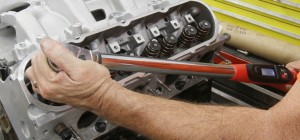Taking good care of your tools helps extend their lives and stops the business from replacing them so soon.
 Daily care in operation and regular maintenance is a smart investment of both time and resources.
Daily care in operation and regular maintenance is a smart investment of both time and resources.
Torque tool care to keep your tools in accurate working condition.
Whether tightening head bolts on an engine, lugs for tire and rim installation or inspecting fastener tolerances on high-performance equipment, care and precision are paramount.
Guidelines are typically provided noting acceptable torque ranges, tightening order and the number of times a fastener must be tightened and loosened to ensure uniform torque application. But these aren’t the only guidelines your workers should observe.
Here’s how you can keep your tools (and workers) in the best working condition.
- Never undertake any bolting work without safety goggles or glasses.
- Always follow manufacturer directions for torque direction, force, torque pattern/sequence, lubrication on fasteners and torque “tighten/release” cycles.
- Never exceed the recommended working range of the torque wrench. Reliable measurements are based on a percentage of the working range. In general, most spring-type mechanical wrenches have a useable range from 20% to 100% of full scale. Most electronic wrenches have a useable range from 10% to 100% of full scale.
- Don’t use accessories or handle extensions unless specifically allowed by the torque wrench manufacturer.
- Take time to inspect the tool and check for worn or cracked sockets. Calibrate the tool regularly. Properly lubricate and replace worn parts.
- Avoid dropping or sliding torque wrenches. Dropping a spring type wrench one on a hard surface can cause the instrument to lose reliable calibration. If you suspect a wrench was dropped, have the tool inspected by the manufacturer or reputable calibration service.
- Always store a torque wrench in a protective case and/or location when not in use.
- Avoid exposure to temperature extremes, high humidity, fluid immersion and corrosive environments.
If using a spring-operated click-type torque wrench, always store it at the lowest level on the scale.
- Avoid marking, etching or placing labels on torque wrenches.
- As most torque wrenches are length specific, always grasp the torque wrench in the center of the handle. If two hands need to be used, place one hand on top of the other.
- Apply torque in a slow, methodical manner and avoid sudden, “jerking” movements.
- When the wrench signals a specific torque is reached, stop pulling immediately.
- After 5000 cycles or up to one year of use, whichever comes first, have your torque wrench inspected and recalibrated by the manufacturer or reputable calibration service. With proper care, a high-quality torque wrench should provide accurate measurements for many years.
Haven’t quite kept up? No problem.
If you haven’t kept up with good tool care, there’s no time like now to start fresh.
Place an order for a supply of new torque tools for your employees and train them on the best practices for tool care today.
Request a product demo or order your already-proven tools online in just a few clicks.



 If using a spring-operated
If using a spring-operated 